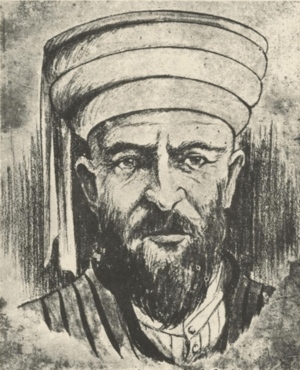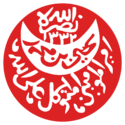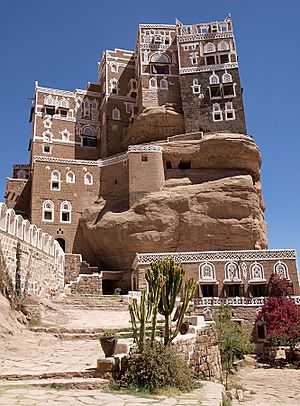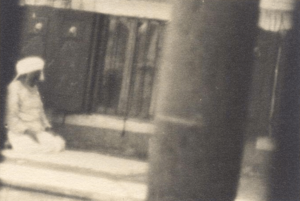Yahya Muhammad Hamid ed-Din facts for kids
Quick facts for kids Imam Yahya HamiduddinArabic: الامام المتوكل على الله يحيى |
|
|---|---|

Portrait of Yahya by Ameen Rihani, 1922. Imam Yahya refused to be photographed throughout his life.
|
|
| King of Yemen | |
| Reign | 30 October 1918 – 17 February 1948 |
| Predecessor | Akdilek Mahmud Pasha (as Ottoman Governor) |
| Successor | Ahmad bin Yahya |
| Imam of Yemen | |
| Reign | 4 June 1904 – 17 February 1948 |
| Predecessor | Muhammad bin Yahya Hamid ad-Din |
| Successor | Ahmad bin Yahya |
| Born | 18 June 1869 Sana'a, Yemen Eyalet, Ottoman Empire |
| Died | 17 February 1948 (aged 78) Hizyaz, Yemen |
| Issue | Ahmad bin Yahya Mohammed bin Yahya (drowned in the Red Sea) Hassan bin Yahya Ali bin Yahya Abdullah bin Yahya (executed) Ibrahim bin Yahya Ismail bin Yahya Al-Qasim bin Yahya Yahya bin Yahya Abdel-Rahman bin Yahya Almtehr bin Yahya Mohsen bin Yahya Al-Abbas bin Yahya (executed) Hussein bin Yahya |
| House | Rassids |
| Father | Muhammad bin Yahya Hamid ad-Din |
| Religion | Zaidi Shia Islam |
| Khatam |  |
Yahya Muhammad Hamid ed-Din (born June 18, 1869 – died February 17, 1948), also known as Imam Yahya, was a very important leader in the history of Yemen. He became the first king of the Mutawakkilite Kingdom of Yemen in 1918. He ruled until he was assassinated in 1948.
Before becoming king, he was the Imam (a religious and political leader) of the Zaydis. This is a branch of Shia Islam. He took on this role in 1904 after his father passed away. In 1918, he became the Imam of all Yemen. His full title showed his high status. It meant he was a leader who trusted in God.
Yahya Muhammad Hamid ed-Din was born in Sana'a, Yemen. He belonged to the al-Qasimi dynasty. This family had ruled parts of Yemen for over 900 years. When Yahya became Imam, he mostly controlled the mountain areas of what is now North Yemen. At that time, the Ottoman Turks also claimed control over the region. Imam Yahya spent his early years trying to make the Ottomans leave. They finally left after they lost World War I.
Imam Yahya was known for keeping Yemen isolated from the outside world. He never traveled outside Yemen. It is even said he never left the Sana'a highlands. He also never saw the Red Sea coast of his own kingdom.
A Leader's Qualities
Many people who met Imam Yahya were impressed by him. In 1925, a British official named Sir Gilbert Clayton visited him. Clayton was amazed by how well Yahya managed his government. He also noted the strong organization of his military.
Another British officer, Lt Col. Harold Jacob, described him as a powerful ruler. He said Imam Yahya was respected because of his religious role. He was also admired for being fair and kind. Jacob noted that Yemen was Imam Yahya's main focus.
Jewish people living in Yemen also spoke highly of him. They saw him as a protector. Imam Yahya brought peace and order to the country. Before his rule, there was a lot of chaos and violence. During his time, Jewish communities generally lived in good conditions. They often supported the Imam.

Yemen's Independence
In 1911, Imam Yahya signed the Treaty of Daan with the Ottomans. This agreement recognized his control over the parts of Yemen ruled by the Zaydi people.
When the Ottoman Empire fell apart in November 1918, big changes came to Yemen. Imam Yahya went to Sana'a to meet with important tribal leaders. On November 17, 1918, many people gathered to declare him the supreme ruler of all Yemen.
One of his first rules was to ban weapons in the capital city, Sana'a. He placed guards at the city gates. This helped bring a time of peace and justice to the region. Many cities, like Mocha and Taiz, accepted his rule. He began building a modern state. He even kept some Ottoman officials to help develop the new government.
In 1919, he created a regular army. Soldiers were recruited from tribes around Sana'a. He also signed many agreements with other countries. These treaties recognized Yemen as an independent country. The first was the Italo-Yemeni Treaty in 1926.
Later, there was a border conflict between Yemen and Saudi Arabia. This led to a war that ended in 1934. The Taif Treaty was signed, which helped define the border. This treaty was important for future agreements between the two countries.
Building the Nation
From 1934 until his death in 1948, Imam Yahya focused on strengthening his power. He worked to create a strong central government. This government answered directly to him. He made his sons governors of important areas. This helped him control the country better.
He also expanded government jobs in Sana'a. He appointed other sons to oversee these new roles. Imam Yahya sent Yemen's first students to study abroad. Some went to Iraq in the 1930s to learn about the military. Others went to Lebanon in the late 1940s to study other subjects. He also tried to boost the economy by starting a Yemeni trading company. Even with these changes, Yemen was still a traditional state. Most big decisions needed his personal approval.
Imam Yahya was generally liked by the Jewish community in Yemen. They saw him as their protector. However, in 1922, he made a rule that stopped Jewish people from leaving Yemen. Even though this rule was official until 1949, many Jews found ways to secretly go to the British area of Aden. In the early 1940s, Imam Yahya quietly allowed some Jewish people to leave. He also kept an old rule that Jewish homes could not be built taller than Muslim homes. He appointed a Jewish leader, Yihya Yitzhak Halevi, to represent his community. This leader also helped collect taxes.
A Tragic End
On February 17, 1948, Imam Yahya was on a short trip outside Sana'a. His car was attacked by an assassin. Imam Yahya and his grandson were shot and killed. This event is known as the Alwaziri coup. The assassin was named Ali Nasser Al-Qardaei.
When people learned of Imam Yahya's death, Yemeni tribes quickly supported his son, Ahmad bin Yahya. They accepted him as the new Imam of Yemen. Armies led by Imam Yahya's sons surrounded Sana'a.
His death shocked many Arab and Muslim leaders. King Abdullah of Jordan compared his death to that of a very important early Muslim leader. Both King Abdulaziz Ibn Saud of Saudi Arabia and King Abdullah supported Imam Ahmad. They were among the first to recognize him as the new leader.
Yemen became a founding member of the Arab League in 1945. It later joined the United Nations in 1947.
See also
- History of Yemen
- Carl Rathjens, an explorer who visited Yemen


